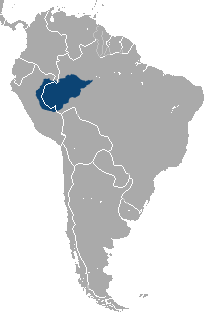Biology:Coppery titi
| Coppery titi[1] | |
|---|---|

| |
| Coppery titi | |
| Scientific classification | |
| Domain: | Eukaryota |
| Kingdom: | Animalia |
| Phylum: | Chordata |
| Class: | Mammalia |
| Order: | Primates |
| Suborder: | Haplorhini |
| Infraorder: | Simiiformes |
| Family: | Pitheciidae |
| Genus: | Plecturocebus |
| Species: | P. cupreus
|
| Binomial name | |
| Plecturocebus cupreus (Spix, 1823)
| |

| |
| Coppery titi range | |
| Synonyms | |
| |
The coppery titi (Plecturocebus cupreus) is a species of titi, a type of New World monkey, from South America.[2] It is found in the Amazon of Brazil and Peru, and perhaps northern Bolivia.[2] It was described as Callithrix cupreus in 1823.[2]
Location, habitat and activity
Coppery titis typically inhabit lowland tropical and sub-tropical forests in areas that flood seasonally. They can also be found in forest understory habitats, young forests, swamp edges, and bamboo thickets. Their populations are mainly found west of the Rio Madeira in Brazil, around the Rio Huallaga in Peru, within the upper Rio Madre de Dios basin in Peru and Bolivia, near the northern Rio-Maranon-Amazonas area, around the Eastern Cordillera in Peru and Ecuador, between the Rios Guamues and the Putumayo, and along the eastern base of the Sierra de la Macarena between the Guyabero and Upia rivers.[3]
Diet
The diet of Coppery titis is composed of fruit and insects. Coppery titis spend nearly 75% of their time feeding eating fruit. The other 25% is spent eating bamboo, leaves, and some insects. The three most consumed fruits are Ficus, Brosimum rubecens, and various berries. Eating time is generally during the early morning and afternoon, while addition feeding on leaves happens before sleeping. Coppery tits rarely eat with other primates, but will eat before or after another primate in the same tree. Coppery titi family groups will often and habitually eat from the same food source together, meaning there could be a social aspect to meal times. Females will vary their diet when lactating, eating nearly twice as many insects. This is due to the bodies higher demand for protein. Males are not known to vary their diets during the time they spend as the primary care-giver.[3]
Behavior
The behavior of Coppery titis is characterized by a diurnal and entirely arboreal nature, spending all of their day in trees. They live in family groups which consist of an adult pair and up to three generations of off-spring. The adult pairs are monogamous and mate for life. Family members may engage in tail-intertwining before and during sleep. As their tails are not prehensile they cannot be used as an additional grip. When first meeting, these titis will smell each other's faces. The titis will also smell their own scent by rubbing their chests on branches - spreading secretions from their sternal gland - before sniffing them. Its possible that this plays a role when marking territory. They have several visual cues which they display when angry or excited. Most notably shaking of their heads and bodies, swaying, looking away from others, or raising and lashing out with their tail. Other cues include barred teeth, a lowered head, closed eyes, protruding lips or an arched back.[3][4]
Communication
Coppery titis are highly vocal animals with a complex set of communicative vocalizations and sounds. Coppery titis will communicate with grunts, screams, whistles and moans. They most frequently communicate with bellows, pumping, and panting, which are the main components of male-female pair duets. These duets are daily performances which occur during or before sunrise near the edge of their territories. Neighboring pairs respond to each other's duets, establishing territorial boundaries. Duets can last up to five minutes, beginning with moaning and ending with honking. For the duration of the duet, males and females will alternate between bellowing calls and panting responses. Between these sequences, the titis will synchronize in a pumping transition. The amount of time spent between synchronized transitions changes over time. Newly paired couples will spend more time between transitions, while older pairs typically show less variability in the length of each sequence between transitions. Weather, it seems, also has an effect on duetting. Coppery titis will spend more time dueting on overcast days than on clear ones. No duets however are made during rain.[3]
Ecological role, predation, and conservation
The ecological role of Coppery tits is an important one for the sake of local biodiversity. Coppery titis scatter the seeds of fruits within their habitats, promoting continued growth. Coppery titis are hunted by birds or prey, feral cats, and possibly capuchin monkeys. Threats from human predation are low, as they do not compose the diets of local hunters, unlike larger neotropical primates.[3][4] Despite this, they are occasionally hunted as bushmeat and for their tails. Due to their location in a remote, isolated region however, the International Union for Conservation of Red List of Threatened Species (IUCN) puts Coppery titis in the Least Concern (LC) category of endangerment.[5]
References
- ↑ Groves, C.P. (2005). "Species Callicebus (Callicebus) cupreus". in Wilson, D.E.; Reeder, D.M.. Mammal Species of the World: A Taxonomic and Geographic Reference (3rd ed.). Baltimore: Johns Hopkins University Press. pp. 142–143. ISBN 0-801-88221-4. OCLC 62265494. http://www.departments.bucknell.edu/biology/resources/msw3/browse.asp?id=12100327.
- ↑ Jump up to: 2.0 2.1 2.2 2.3 Heymann, E.W.; Calouro, A.M.; Fialho, M.S.; de la Torre, S.; Vermeer, J. (2021). "Plecturocebus cupreus". IUCN Red List of Threatened Species 2021: e.T127530593A192453653. doi:10.2305/IUCN.UK.2021-1.RLTS.T127530593A192453653.en. https://www.iucnredlist.org/species/127530593/192453653. Retrieved 19 November 2021.
- ↑ Jump up to: 3.0 3.1 3.2 3.3 3.4 Sproll, Ingrid. "Callicebus cupreus coppery titi". University of Michigan Museum of Zoology. https://animaldiversity.org/accounts/Callicebus_cupreus/.
- ↑ Jump up to: 4.0 4.1 "Titi Monkey (Coppery) / Callicebus cupreus". Dudley Zoo. https://www.dudleyzoo.org.uk/animal/titi-monkey-coppery/.
- ↑ "COPPERY TITI PLECTUROCEBUS CUPREUS". New England Conservancy. https://www.neprimateconservancy.org/coppery-titi.html.
External links
Wikidata ☰ {{{from}}} entry


